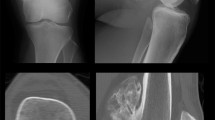Abstract
Bone tumor surgery is extremely challenging, particularly when tumors are located in tightly confined anatomical areas and abutting critical organs and neurovascular structures. Tumor resection requires good cutting accuracy to ensure safety, to achieve negative margins, and to preserve critical structures when possible. The purpose of this paper was to review the literature on the surgical advances for bone tumor surgery published within the last year. The majority of literature identified focused on computer-assisted surgical approaches. There is increasing evidence that 3D navigation plays an important role in the resection of bone tumors. Reconstruction materials that encourage healing and prevent infections are also in development. Optimal care includes execution of a well-developed pre-operative plan using a multidisciplinary approach led by the orthopaedic oncologist.
Similar content being viewed by others
References
Papers of particular interest, published recently, have been highlighted as: • Of importance •• Of major importance
Fletcher, C.D.M., World Health Organization, and International Agency for Research on Cancer., WHO classification of tumours of soft tissue and bone. 4th ed. World Health Organization classification of tumours. 2013, Lyon: IARC Press. 468 p. Update on the comprehensive classification of tumours of soft tissue and by the world health organization.
Moore AT, Bohlman HR. Metal hip joint: a case report. 1942. Clin Orthop Relat Res. 2006;453:22–4.
Italiano A et al. Advanced chondrosarcomas: role of chemotherapy and survival. Ann Oncol. 2013;24(11):2916–22.
Evans HL, Ayala AG, Romsdahl MM. Prognostic factors in chondrosarcoma of bone: a clinicopathologic analysis with emphasis on histologic grading. Cancer. 1977;40(2):818–31.
Sheth DS et al. Chondrosarcoma of the pelvis. Prognostic factors for 67 patients treated with definitive surgery. Cancer. 1996;78(4):745–50.
Pring ME et al. Chondrosarcoma of the pelvis. A review of sixty-four cases. J Bone Joint Surg Am. 2001;83-A(11):1630–42.
Weber KL, Pring ME, Sim FH. Treatment and outcome of recurrent pelvic chondrosarcoma. Clin Orthop Relat Res. 2002;397:19–28.
O’Donnell PW et al. Chemotherapy influences the pseudocapsule composition in soft tissue sarcomas. Clin Orthop Relat Res. 2014;472(3):849–55. Neoadjuvant chemotherapy contributed to the development of a pseudocapsule and decreased the number of tumors with malignant cells identified within and beyond the pseudocapsule.
Cartiaux O et al. Surgical inaccuracy of tumor resection and reconstruction within the pelvis: an experimental study. Acta Orthop. 2008;79(5):695–702.
Delloye C et al. Pelvic reconstruction with a structural pelvic allograft after resection of a malignant bone tumor. J Bone Joint Surg Am. 2007;89(3):579–87.
Ding GX, Munro P. Radiation exposure to patients from image guidance procedures and techniques to reduce the imaging dose. Radiother Oncol. 2013;108(1):91–8.
Schils F, Schoojans W, Struelens L. The surgeon's real dose exposure during balloon kyphoplasty procedure and evaluation of the cement delivery system: a prospective study. Eur Spine J. 2013;22(8):1758–64.
Allam Y et al. Computer tomography assessment of pedicle screw placement in thoracic spine: comparison between freehand and generic 3D-based navigation techniques. Eur Spine J. 2013;22(3):648–53. In conclusion, 3D navigation-assisted pedicle screw placement proved superior to the freehand technique in the thoracic spine.
Aponte-Tinao LA et al. Multiplanar osteotomies guided by navigation in chondrosarcoma of the knee. Orthopedics. 2013;36(3):e325–30. Concluded that navigation with adequate preoperative planning allows surgeons to intraoperatively reproduce the planned resection with accuracy in complex multiplanary resections.
Campos WK, Gasbarrini A, Boriani S. Case report: curetting osteoid osteoma of the spine using combined video-assisted thoracoscopic surgery and navigation. Clin Orthop Relat Res. 2013;471(2):680–5. Reports the intergration of navigation and minimally invasive surgical techniques for the resection of a spinal tumor.
Cartiaux O et al. Computer-assisted planning and navigation improves cutting accuracy during simulated bone tumor surgery of the pelvis. Comput Aided Surg. 2013;18(1–2):19–26. Cutting accuracy during simulated bone cuts of the pelvis was improved by using a navigation system.
Cartiaux O et al. Improved accuracy with 3D planning and patient-specific instruments during simulated pelvic bone tumor surgery. Ann Biomed Eng. 2014;42(1):205–13. PSI technology demonstrated an equivalent value-added for bone cutting accuracy compared to navigation and requires no intraoperative registration and tracking.
Cengic T et al. Intraoperative gamma hand-held probe navigation in resection of osteoid osteoma tumor–report of two cases. Acta Clin Croat. 2013;52(2):261–5.
Gerbers JG, Jutte PC. Hip-sparing approach using computer navigation in periacetabular chondrosarcoma. Comput Aided Surg. 2013;18(1–2):27–32. In this case report, the authors document the safe use of navigation, which allowed the resection to be performed while saving the hip joint.
Jeys L et al. Can computer navigation-assisted surgery reduce the risk of an intralesional margin and reduce the rate of local recurrence in patients with a tumour of the pelvis or sacrum? Bone Joint J. 2013;95-B(10):1417–24. The authors present their experience using navigation-assisted surgery in 31 patients and found it reduced intralesional surgeries for the pelvis and sacrum.
Kang HG, Cho CN, Kim KG. Percutaneous navigation surgery of osteoid osteoma of the femur neck. Minim Invasive Ther Allied Technol. 2014;23(1):58–62.
Khan F et al. Haptic robot-assisted surgery improves accuracy of wide resection of bone tumors: a pilot study. Clin Orthop Relat Res. 2013;471(3):851–9.
Mezger U, Jendrewski C, Bartels M. Navigation in surgery. Langenbecks Arch Surg. 2013;398(4):501–14.
Miyazaki T et al. Chondroblastoma of the distal femur resected through a small fenestra via computed tomography navigation and endoscopy: a case report. J Med Case Rep. 2013;7(1):164.
Ritacco LE et al. Accuracy of 3-D planning and navigation in bone tumor resection. Orthopedics. 2013;36(7):e942–50.
Ritacco LE et al. Bone tumor resection: analysis about 3D preoperative planning and navigation method using a virtual specimen. Stud Health Technol Inf. 2013;192:1162. Report on a reliable method of evaluating accuracy of the resection using CT reconstructions of the surgical specimen.
Satcher Jr RL. How intraoperative navigation is changing musculoskeletal tumor surgery. Orthop Clin North Am. 2013;44(4):645–56.
So TY, Lam YL, Mak KL. Computer-assisted navigation in bone tumor surgery: seamless workflow model and evolution of technique. Clin Orthop Relat Res. 2010;468(11):2985–91.
Stubig T et al. 3D-navigated implantation of the glenoid component in reversed shoulder arthroplasty. Feasibility and results in an anatomic study. Int J Med Robot. 2013;9(4):480–5.
Sugano N. Computer-assisted orthopaedic surgery and robotic surgery in total hip arthroplasty. Clin Orthop Surg. 2013;5(1):1–9.
Wong KC, Kumta SM. Joint-preserving tumor resection and reconstruction using image-guided computer navigation. Clin Orthop Relat Res. 2013;471(3):762–73. Report on 6 cases demonstrating the benefit of navigation in performing joint-preserving tumor resections.
Wong KC, Kumta SM. Computer-assisted tumor surgery in malignant bone tumors. Clin Orthop Relat Res. 2013;471(3):750–61. Reports outcomes in 20 patients who underwent navigation-assisted surgery.
Wong KC, Kumta SM. Use of computer navigation in orthopedic oncology. Curr Surg Rep. 2014;2:47.
Gao Q et al. Modeling of the bony pelvis from MRI using a multi-atlas AE-SDM for registration and tracking in image-guided robotic prostatectomy. Comput Med Imaging Graph. 2013;37(2):183–94.
Akiyama T et al. Silver oxide-containing hydroxyapatite coating has in vivo antibacterial activity in the rat tibia. J Orthop Res. 2013;31(8):1195–200.
Coathup MJ et al. Long-term survival of cemented distal femoral endoprostheses with a hydroxyapatite-coated collar: a histological study and a radiographic follow-up. J Bone Joint Surg Am. 2013;95(17):1569–75.
De Giglio E et al. An innovative, easily fabricated, silver nanoparticle-based titanium implant coating: development and analytical characterization. Anal Bioanal Chem. 2013;405(2–3):805–16.
Della Valle C et al. A novel antibacterial modification treatment of titanium capable to improve osseointegration. Int J Artif Organs. 2012;35(10):864–75.
Gulati K et al. Biocompatible polymer coating of titanium nanotube arrays for improved drug elution and osteoblast adhesion. Acta Biomater. 2012;8(1):449–56.
He P et al. Enhanced osteoinductivity and osteoconductivity through hydroxyapatite coating of silk-based tissue-engineered ligament scaffold. J Biomed Mater Res A. 2013;101(2):555–66.
Jennison T, McNally M, Pandit H. Prevention of infection in external fixator pin sites. Acta Biomater. 2014;10(2):595–603.
Kose N et al. A silver ion-doped calcium phosphate-based ceramic nanopowder-coated prosthesis increased infection resistance. Clin Orthop Relat Res. 2013;471(8):2532–9.
Biau D et al. Survival of total knee replacement with a megaprosthesis after bone tumor resection. J Bone Joint Surg Am. 2006;88(6):1285–93.
Bruns J et al. Cementless fixation of megaprostheses using a conical fluted stem in the treatment of bone tumours. J Bone Joint Surg (Br). 2007;89(8):1084–7.
Muller PE et al. Internal hemipelvectomy and reconstruction with a megaprosthesis. Int Orthop. 2002;26(2):76–9.
Natarajan MV, Mohanlal P, Bose JC. The role of limb salvage surgery and custom megaprosthesis in multiple myeloma. Acta Orthop Belg. 2007;73(4):462–7.
Rudert M et al. Partial pelvic resection (internal hemipelvectomy) and endoprosthetic replacement in periacetabular tumors. Oper Orthop Traumatol. 2012;24(3):196–214.
Aponte-Tinao LA et al. The principles and applications of fresh frozen Allografts to bone and joint reconstruction. Orthop Clin North Am. 2014;45(2):257–69.
Campanacci DA et al. Vascularised fibular grafts as a salvage procedure in failed intercalary reconstructions after bone tumour resection of the femur. Injury. 2014;45(2):399–404.
Harris JD et al. Exceptional functional recovery and return to high-impact sports after Van Nes rotationplasty. Orthopedics. 2013;36(1):e126–31.
Agrawal N et al. Outcomes analysis of the role of plastic surgery in extremity sarcoma treatment. J Reconstr Microsurg. 2013;29(2):107–11.
Falagas ME et al. Impact of vacuum-assisted closure (VAC) therapy on clinical outcomes of patients with sternal wound infections: a meta-analysis of non-randomized studies. PLoS One. 2013;8(5):e64741.
Karlakki S et al. Negative pressure wound therapy for management of the surgical incision in orthopaedic surgery: a review of evidence and mechanisms for an emerging indication. Bone Joint Res. 2013;2(12):276–84.
Hacihaliloglu I et al. Non-iterative partial-view 3D ultrasound to CT registration in ultrasound-guided computer-assisted orthopedic surgery. Int J Comput Assist Radiol Surg. 2013;8(2):157–68.
Bullock P et al. Integration of image guidance and rapid prototy** technology in craniofacial surgery. Int J Oral Maxillofac Surg. 2013;42(8):970–3.
Compliance with Ethics Guidelines
Conflict of Interest
Justin E. Bird declares that he has no conflict of interest.
Human and Animal Rights and Informed Consent
This article does not contain any studies with human or animal subjects performed by any of the authors.
Author information
Authors and Affiliations
Corresponding author
Additional information
This article is part of the Topical Collection on Sarcomas
Rights and permissions
About this article
Cite this article
Bird, J.E. “Advances in the Surgical Management of Bone Tumors”. Curr Oncol Rep 16, 392 (2014). https://doi.org/10.1007/s11912-014-0392-2
Published:
DOI: https://doi.org/10.1007/s11912-014-0392-2




